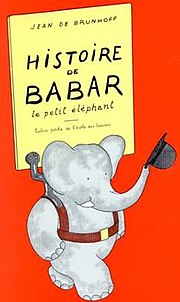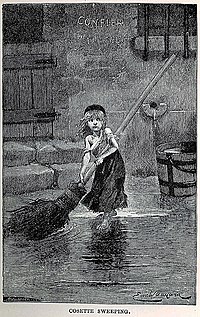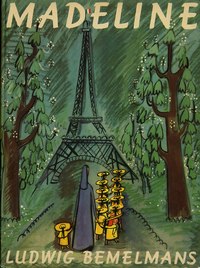The studios of Walt Disney and Hana-Barbera don’t have the lock on fictional characters. Many of Americans’ most beloved cartoon, storybook, and movie heros and heroines come from writers and storytelling traditions in France. Some of the characters are actually Belgian or Swiss but are very popular in the French language. I’ve listed below some familiar (and some not-so-familiar) French fantasy and fairytale people in no particular order.
Belle, the Beast, Gaston, Lumiere, Mrs. Potts and her son Chip are from Beauty and the Beast. The original story, La Belle et la Bete, was written by Gabrielle-Suzanne Barbot de Villeneuve (1695-1755) and published in 1740 in the collection La jeune américaine, et les contes marins (The Young American, and Tales of the Sea). There were also other “searching for the lost husband” stories throughout Europe at the time.
Aramis, Pothos, Athos, D’Artagnan, and Milady de Winter are all characters from Alexander Dumas’s novel Les Trois Mousquataires (The Three Musketeers). D’Artagnan’s character was based on a real person, Charles de Batz-Castelmore (c.1611-1673), who was Comte d’Artagnan and served as captain of the Musketeers of the Guard.
Babar the elephant and his family are characters from the Babar series of books by Jean de Brunhoff (1900-1937 from tuberculosis). Brunhoff’s wife Cecille de Brunhoff first told these stories to their children, and Jean published L’Histoire de Babar in 1931. Babar, his wife Cecile, and their children Pom, Flora, and Alexander go on many adventures in Jean’s original seven books. Jean’s son Laurent continued Babar’s adventures, adding 10 more books to the series.
Asterix the Gaul and Obelisk are from the Asterix comic book series created by artist Albert Uderzo (b. 1927 in Normandy) and writer Rene Goscinny (1926-1977). The stories center on a village of ancient Gauls who resist the Roman occupiers. The books have been translated into 100 languages.
Erik is the main character from Gaston Leroux’s tragic tale of obsession, The Phantom of the Opera. The novel first appeared in serialized form in 1809. The disfigured Erik makes his home beneath the Opera Garnier house in Paris. Having toured this very opera house, I think they could add an underground component and feature someone playing the organ.
Inspector Cloiseau is a bumbling French inspector from Blake Edwards’ Pink Panther movies. Cloiseau was played by Peter Sellers and Alan Arkin.
Jean Valjean is the protagonist from Victor Hugo’s 1862 novel Les Miserables. After stealing a loaf of bread and escaping prison, Valjean is pursued for 20 years by the relentless policeman Falvert. Valjean takes care of the child Cosette (in the image below) when Cosette’s mother dies.
Titeuf is a comic book boy created by the Swiss artist Zep. The series is the greatest moneymaker in the French comics market.
Pepe le Pew is the Parisian skunk character created by Chuck Jones for Warner Brothers. The French version of the same character is Pépé le putois, an Italian skunk with a strong Italian accent.
Fifi la Fume was another animated skunk, a teenaged girl skunk this time, in Warner Brothers’ animated series Tiny Toon Adventures.
Jean-Luc Picard was the Enterprise Captain from Star Trek: The Second Generation. He was played by Yorkshire, England-born actor Patrick Stewart. The Picard character was from La Barre, Burgundy, France, born in 2305. In the fourth season’s “Family” episode, Picard travels to the family’s La Barre vineyard for an uneasy visit with his brother Robert and adoring nephew Rene. These two characters later died in a fire.
Captain Nemo is featured in two novels by Jules Verne (1828-1905): Twenty Thousand Leagues Under the Sea (1870) and The Mysterious Island (1874). “Nemo” is Latin for “no one.” Perhaps the most famous portrayal of Captain Nemo was by James Mason in the 1954 Disney movie version of 20,000 Leagues Under the Sea.
The Smurfs (originally Les Schtroumpfs in French and pictured below) are small blue creatures who live in medieval European forests. They were created in a series of comic strips by Belgian cartoonist Peyo. They first appeared in 1958 in the magazine Le Journal de Spirou. Americans know them best through the Hana Barbera animated TV series .
In 1697, Charles Perrault published Histoires ou Contes du Temps passe: Les Contes de ma Mere l’Oye (Tales and Stories of the Past with Morals: Tales of Mother Goose. In that collection were four unforgettable characters: Puss-in-Boots (below right), Sleeping Beauty (below left), Cinderella, and Little Red Riding Hood. There is a bust of Perrault in the Tuileries Garden with Puss-in-Boots and four girls dancing around Perrault.
Sophie Neveu is the female lead in Dan Brown’s novel The Da Vinci Code. Neveu is played in the movie by Audrey Tatou. Bezu Fache, another French character, is played by Jean Reno.
Michel Gerard is the concierge at the Dragonfly Inn on the TV series Gilmore Girls. He is played by Canadian actor Yanic Truesdale.
Le Petit Prince–the Little Prince–from the book by Antoine Saint-Exupery. See my post on October 24.
Bécassine first appeared in 1905 in the magazine “La Semaine de Suzette,” a magazine for little girls. Jacqueline Rivière drew this small, innocent girl from Brittany who was full of good intentions and energy. Bécassine was an aviatrix, teacher, alpinist, and a nanny. She is somewhat controversial for showing an ignorant, naive Breton.

Esmeralda (the gypsy girl) and Quasimodo (the hunchback) are characters from Victor Hugo’s 1831 novel The Hunchback of Notre Dame.
Madeline is a little French girl student in American author Ludwig Bemelmanns’ series of books set in late 1940s France.
Loopy de Loop is an animated wolf from Hanna and Barbera studios. Loup is “wolf” in French.
Tin-Tin (shown below with his dog Snowy–Milou in the original French) is a boy-adventurer in the series of 23 adventure comic books created by Belgian cartoonist Georges Remi, known by his reversed initials as “Herge.” Tin-Tin and Snowy (Milou in French) are enormously popular in Europe, and there are many shops in Paris which sell Tin-Tin figures, books, and posters.
















One Comment